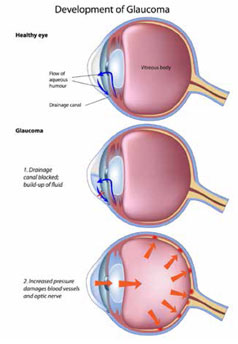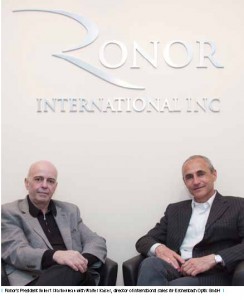By Netan Choudhry, M.D, FRCSC and Jennifer George
Glaucoma affects nearly 65 million people worldwide. Sometimes called the “silent thief,” it often causes irreversible damage before one experiences any symptoms. As a result, nearly half of those suffering with the disease are unaware of it. Although glaucoma has been identifiable for centuries, its cause is unknown in most cases. Currently, there is no cure for the disease, making it one of the leading causes of blindness around the world.
Glaucoma damages the optic nerve, the part of the eye that carries the images we see from the retina to the brain. There are many different kinds of glaucoma and a variety of treatment options for each. In the healthy eye, a clear liquid known as aqueous humor circulates inside the front portion of the eye. In order to maintain a constant healthy eye pressure, the eye continually produces a small amount of aqueous humor. An equal amount of this fluid flows out of the eye through a microscopic drain called the trabecular meshwork in the drainage angle. In glaucoma, the aqueous humor does not flow through the drainage angle correctly. As a result, fluid pressure in the eye increases. This extra force puts pressure on the optic nerve in the back of the eye, causing damage to the nerve fibres and peripheral visual field loss.
 Glaucoma comes in various forms. It is generally divided into three classes: open angle glaucoma, narrow angle glaucoma, and secondary glaucoma. Open angle glaucomas occur when the access to the drainage angle is open. While it is important to note that not all people with elevated intraocular pressures will develop glaucoma, it is well-established that elevated intraocular pressures are a risk factor for glaucoma development. A form of open angle glaucoma without elevated intraocular pressures is known as low-tension or normal-tension glaucoma. This form may be associated with poor blood flow to the optic nerve. Narrow angle glaucoma can occur when access to the drainage angle is blocked by adjacent structures inside the eye. This type of glaucoma can result in an acutely elevated eye pressure, which is a painful event known as acute angle closure. Often, a laser procedure called a peripheral iridotomy is necessary to prevent this acute event from occurring in at-risk eyes. Lastly, secondary glaucomas can result from a variety of intraocular or systemic diseases, from diabetes to retinal detachments to intraocular inflammation or uveitis.
Glaucoma comes in various forms. It is generally divided into three classes: open angle glaucoma, narrow angle glaucoma, and secondary glaucoma. Open angle glaucomas occur when the access to the drainage angle is open. While it is important to note that not all people with elevated intraocular pressures will develop glaucoma, it is well-established that elevated intraocular pressures are a risk factor for glaucoma development. A form of open angle glaucoma without elevated intraocular pressures is known as low-tension or normal-tension glaucoma. This form may be associated with poor blood flow to the optic nerve. Narrow angle glaucoma can occur when access to the drainage angle is blocked by adjacent structures inside the eye. This type of glaucoma can result in an acutely elevated eye pressure, which is a painful event known as acute angle closure. Often, a laser procedure called a peripheral iridotomy is necessary to prevent this acute event from occurring in at-risk eyes. Lastly, secondary glaucomas can result from a variety of intraocular or systemic diseases, from diabetes to retinal detachments to intraocular inflammation or uveitis.
There are various treatment options for glaucoma. The mainstay of glaucoma management today includes eye drops that serve to either reduce the amount of fluid produced by the eye or aid in fluid drainage through the pathways that already exist in the eye. In some instances, laser therapy can be utilized to help remodel the trabecular meshwork and facilitate improved outflow. The goal of glaucoma management is to reduce the intraocular pressure, thereby reducing the stress on the optic nerve and preventing visual field loss. It is important to note that once injury to the nerve fibres has occurred, it is impossible to reverse it.
As a last resort, ophthalmologists may turn to surgical options to lower the eye pressure. Trabeculectomy is a surgery in which the eye’s natural drainage system is bypassed by creating a natural filter through the eye wall. Other surgical approaches involve utilizing a glaucoma drainage device that can shunt fluid from inside the eye to a reservoir that is implanted under the conjunctiva.
In recent years, ophthalmologists have pioneered new forms of surgical interventions and implants that may improve outflow through minimally invasive means. The proliferation of MIGS, or minimally invasive glaucoma surgeries, aims to lower intraocular pressures through less aggressive surgical interventions like those mentioned above. While varied, these forms of surgery often attempt to manipulate the eye’s natural drainage system, as opposed to creating a bypass, to achieve results. Time will tell if these new surgical modalities will be effective in minimizing the progression of vision loss from glaucoma in the long term.
It is important to note that glaucoma usually presents with no symptoms in its early stages. Visual field loss from glaucoma is often peripheral, so even patients with advanced glaucoma may not be aware that their optic nerves have been damaged. Proper treatment can often delay or slow further vision loss that might result. It is particularly important for certain individuals to be evaluated for glaucoma. This includes those over the age of 60, the relatives of people with glaucoma, people of African descent and anyone with elevated eye pressure. While optic nerve damage is currently irreversible and there is no cure for glaucoma, vision loss can usually be prevented if the disease is detected in its early stages.



